Green star (astronomy)
In astronomy, a green star is a white or blue star that appears green due to an optical illusion. There are no truly green stars, because the color of a star is more or less given by a black-body spectrum and this never looks green.[1] However, there are a few stars that appear green to some observers. This is usually because of the optical illusion that a red object can make nearby objects look greenish. There are some multiple star systems, such as Antares, with a bright red star where this illusion makes other stars in the system look green.
Why stars do not look green
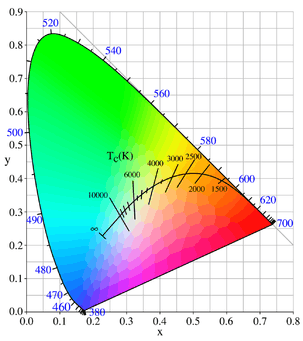

A star is usually close to being a black body, give or take a few spectral lines, so its color is usually more or less the color of a black body. The color of a black body lies on the Planckian locus in the middle of the diagram shown here. As can be seen, this locus happens to pass through red, orange, yellow, white, and light blue areas, and one can indeed see many stars of these colors. On the other hand, it does not pass through green, indigo (dark blue) or violet areas, so stars that appear to have these colors are rare and depend on some additional optical effect.[2]
The (blackbody) colors of stars are sometimes confused with the colors of the spectrum. The spectral (rainbow) colors are those on the curved part of the boundary of the diagram on the right. As can be seen, the red, orange, yellow and blue rainbow colors happen to be much the same as blackbody colors. However, stars whose peak emission is green light also emit much red and blue light, and the human visual system happens to interpret this mixture of colors as whitish rather than green. So the fact that some spectral colors appear as star colors is more a quirk of human color vision than a property of stars: if one uses an instrument such as a spectroscope that is better at distinguishing wavelengths of light, then all spectral colors look completely different from star colors. All sufficiently hot stars look about the same shade of blue (and not violet as claimed in some popular accounts). The reason for this is that at sufficiently large temperatures (above about 20,000 K) all blackbody spectra look about the same in visible light, though they can differ a lot at shorter wavelengths. Although their maximum output at visible wavelengths is at violet, they put out enough light at other wavelengths to look light blue: the color at the end of the Planckian locus rather than the color at the end of the spectrum. Human color vision is in fact more complicated than suggested by the explanation above, and in particular the perceived color of an object depends not only on the light it emits, but also on the colors of nearby objects. For example, a blue object close to a red object may appear somewhat greenish; this effect accounts for many apparently green stars.
Objects that resemble green stars
Although there are no truly green stars, there are many astronomical objects that can sometimes appear to be green stars. This section lists some of them.
Multiple stars
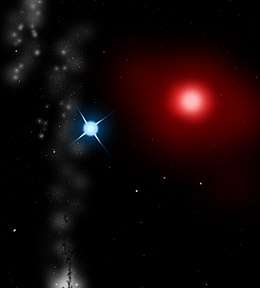
Elias Loomis, A Treatise on Astronomy, 1877, page 299
There a few stars in double or multiple star systems that appear greenish, even though they are really blue or white. This can happen if the star system contains a large red or orange star.[3] An optical illusion causes things close to the red star to appear slightly greenish.
The classical example is Antares B, the blue companion of the red supergiant Antares.[4]
Other examples include the star system Almach, and Sigma Cassiopeiae, a binary star 1500 light-years from Earth.
Sigma Cassiopeiae has a green-hued primary of magnitude 5.0 and a blue-hued secondary of magnitude 7.3.
Nebulae
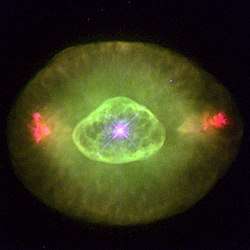
Some planetary nebulae glow green, especially if they contain oxygen. These nebulae, or the stars within them (usually Wolf-Rayet stars) may appear to be green stars. Some examples are the planetary nebulae NGC 6572, NGC 6826 and NGC 7009.
Beta Librae
Burnham (1978, p.1105) discussing Zubeneschamali.
The star Beta Librae (Zubeneschamali) is usually reported to be white by modern observers.[5] However its color is controversial, and many earlier observers state that it is green.[6] There seems to be no consensus about what its color really is, and no generally accepted explanation for why some observers see it as green.[7]
Uranus
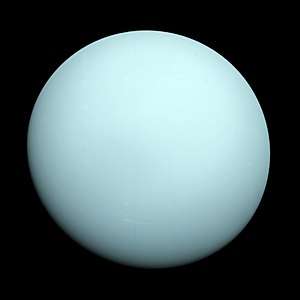
The planet Uranus, occasionally mistaken for a star and once cataloged as one as 34 Tauri, can appear greenish as it has a lot of methane that absorbs red light.
The Sun
The Sun can sometimes appear as a green spot for a second or two as it is rising or setting: this is known as green flash. Roughly speaking, the red light from the Sun is blocked by Earth, the blue light is scattered by the atmosphere, and the green light is refracted by the atmosphere to the observer.[8] A similar effect can occasionally be seen with other astronomical objects such as the moon and bright planets.
Furthermore, the Sun emits more green photons than any other color; i.e. it peaks in the green part of the visible spectrum.
False color images
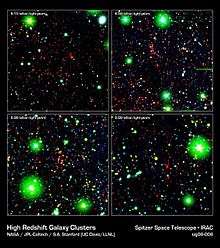
Astronomical images are sometimes printed in false colors, which can make stars look green.
See also
- Spectral classification
Sources
- Burnham, Robert (1978). Burnham's celestial handbook: an observer's guide to the universe beyond the solar system. 2. New York: Dover. ISBN 9780486235684.
- Feynman, Richard (1997). Surely you're joking, Mr. Feynman!. W. W. Norton & Company. ISBN 978-0-393-31604-9.
References
- Fraser Cain (10 February 2009). "Are there Green Stars?". Universe Today – space and astronomy news. Retrieved 27 August 2017.
- "Gröna stjärnor? Varför finns det inga gröna stjärnor?". Allt om Vetenskap (in Swedish) (2). 9 October 2012. Retrieved 27 August 2017.
- Elias Loomis (1870). A Treatise on Astronomy. Harper and Brothers, New York.
- Fred Schaaf (1983). Wonders of the Sky: Observing Rainbows, Comets, Eclipses, the Stars, and Other Phenomena. Courier Corporation. p. 213. Retrieved 7 September 2017.
- "Basic data: * bet Lib -- Variable star". Centre de Données astronomiques de Strasbourg. Retrieved 20 May 2015.
- Robert Burnham (1978). Burnham's celestial handbook: an observer's guide to the universe beyond the solar system. 2. Dover, New York. p. 1105. ISBN 9780486235684. Retrieved 26 August 2017.
- James B. Kaler (2006). "Zubeneschamali". Stars. University of Illinois. Archived from the original on 14 July 2006. Retrieved 26 August 2017.
- Andrew T. Young. "Explaining Green Flashes". Retrieved 26 August 2017.
External links
- Why are there no green stars? by Phil Plait